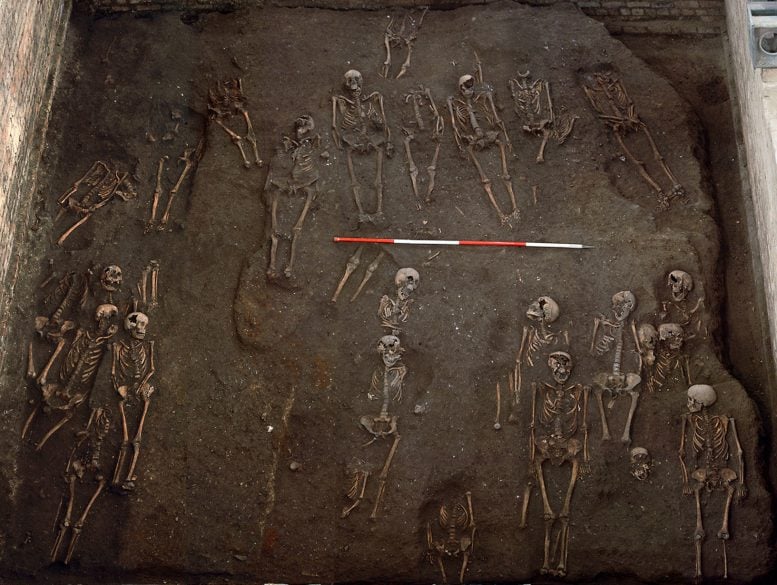Unveiling Medieval Life Secrets Through "Bone Biographies"

The 2010 excavation on the old site of the Hospital of St. John the Evangelist yielded numerous individual remains. The excavation was conducted by Cambridge Archaeological Unit/St John’s College.
Experts then embarked on a significant research venture, bringing together several 'bone biographies'. These biographies offer a glimpse into the lives of the individuals from medieval Cambridge, as told through the analysis of their skeletal remains, particularly during the Black Death era.
This research parallels a study focusing on medieval poverty, in which remains from a former hospital's cemetery, once home to the poor and sick, were examined. Nearly 500 skeletal remains were studied by University of Cambridge archaeologists, the majority of which were discovered throughout the city. The remains were dated between the 11th and 15th centuries, originating from various excavations since the 1970s.
Advanced analysis techniques were employed to study the diets, activities, DNA, and physical traumas of the individuals, covering a wide array of social types. In-depth accounts, aka "osteobiographies", are available on a newly developed website by Cambridge University's After the Plague project.
An osteobiography provides a comprehensive understanding of an individual's life," according to the lead researcher Prof John Robb from Cambridge’s Department of Archaeology. "Our team used techniques familiar from studies such as Richard III’s skeleton, to reveal details of unknown lives – people we would never learn about in any other way."
Dr Sarah Inskip, After the Plague researcher, emphasizes the significance of applying these osteobiographies to ordinary citizens rather than historical elites.
To maintain respect for the subjects, pseudonyms were given to each individual based on a statistical analysis of common names during the period.
The set of remains a.k.a ‘Dickon’ could provide significant insights into the era. Born in Cambridge between 1289 and 1317, 'Dickon' lived during the Great Famine of 1315-1320, which stunted his growth. Despite this, he reached a height of 5ft 2in, with muscles that indicate a labor-intensive life. He likely died from the plague.
The website also provides information on a few other individuals such as 92 (‘Wat’), a survivor of the plague who eventually died from cancer and 335 (‘Anne’), a woman who experienced multiple injuries which stunted her right leg.
The website coincides with a publication by the same team in the journal Antiquity. The study focuses on the past inhabitants of the hospital of St. John the Evangelist. After its establishment around 1195, the institution catered to the "poor and infirm" until its dissolution in 1511.
Medieval Cambridge was filled with need, according to Robb. "A few of the luckier poor people got bed and board in the hospital for life. Selection criteria would have been a mix of material want, local politics, and spiritual merit."
The study provides a unique insight into how a "medieval benefits system" functioned. The inmates were not only required to show piety but also had to pray for the benefactors’ souls, aimed at easing their journey through purgatory. "A hospital was a prayer factory."
The osteobiography produced from the analysis of remains uncovered from the main cemetery of St. John the Evangelist's hospital in Cambridge provides us with a glimpse into the life of a man we'll refer to as 'Wat'. Likely born between 1316-1347, and dying between 1375-1475, Wat probably spent his final years in the hospital after struggling with poverty in his old age. His life included surviving the Black Death, and he eventually died in the hospital due to cancer. Credit: Mark Gridley/After the Plague
Careful study of molecular, bone and DNA data from more than 400 remains in the hospital's main cemetery has revealed that these people were, on average, one inch shorter than their peers from the town, died earlier, and demonstrated signs of tuberculosis.
The inmates' remains often carried the markers of childhoods steeped in disease and malnutrition. Yet, their rates of bodily trauma were lower, indicating that life in the hospital may have offered a respite from physical duress or hazards.
Children's remains unearthed from the hospital cemetery showed that they were delayed in growth by up to five years for their age. "Most of the children in the hospital were probably orphans," commented Robb. Signs of injuries and anemia were widespread, with nearly one-third of them exhibiting rib lesions that signify respiratory illnesses such as tuberculosis.
The cemetery also held the remains of up to eight residents who had isotope levels revealing a poor diet in their later years. These individuals were possibly part of the "shame-faced poor," those who had fallen from a comfortable life into abject poverty, possibly due to being unfit for work.
Robb pointed out that theological doctrines advised providing aid for the shame-faced poor as their circumstances challenged the moral order by indicating that despite living a virtuous and prosperous life, one could still fall prey to misfortunes.
Image credit: Cambridge Archaeological Unit - Members of the Cambridge Archaeological Unit excavating the Hospital of St. John the Evangelist in 2010.
The researchers proposed that the diversity of the hospital residents, ranging from destitute orphans and devout scholars to those once prosperous, could have contributed to attracting a variety of philanthropists.
The researchers successfully identified some skeletons belonging to the early scholars of the University of Cambridge, based on the arm bones.
In the general townsmen population, almost everyone had asymmetric arm bones, their right humerus being stronger than the left, indicating rigorous work schedules, especially during early adulthood.
However, around ten men from the hospital had symmetrical humeri, yet showed no evidence of a deprived childhood, stunted growth, or lingering disease. Most of these men were from the late 14th and 15th centuries.
Returns an artist's impression of the medieval marketplace in Cambridge. Credit: Mark Gridley/After the Plague
"Presumably, these men did not frequently engage in manual labor or craftwork and enjoyed generally good health and adequate nutrition, usually living to an old age. They were likely early scholars of the University of Cambridge," remarked Robb.
Robb added, "University clergymen did not enjoy the lifelong support of their religious order's clergy. Most scholars relied on family wealth, earnings from teaching, or charitable patronage.
When disease or frailty struck, less affluent scholars faced the risk of poverty. As the university expanded, more scholars might have ended up buried in hospital cemeteries."
Isotope analysis suggested that most of the early Cambridge students hailed from eastern England, with a few from the dioceses of Lincoln and York.
An overview of medieval Cambridge, displaying the locations of the three primary burial sites utilized in the After the Plague research project. Credit: V. Herring/Antiquity
The team employed skeletons from three different sites for this study. The University's New Museums Site's renovation in 2015 revealed remains from a former Augustinian Friary. The researchers also used skeletons excavated in the 1970s from the yard of a medieval parish church named 'All Saints by the Castle.'
The team undertook an inventory of each skeleton, from which they extracted samples for radiocarbon dating and DNA analysis. "We had to manage hundreds of bone samples circulating all around," reported Robb.
In 1348-9, the bubonic plague, known as the Black Death, devastated Cambridge, claiming the lives of 40-60% of its inhabitants. Most of the deceased were laid to rest in town cemeteries or plague pits like the one on Bene’t Street next to the former friary.
However, the team relied on the World Health Organization's methods to calculate "Disease Adjusted Life Years" to show that bubonic plague might have only been tenth or twelfth on the list of serious health threats encountered by medieval Europeans.
Instead, routine diseases, such as measles, whooping cough, and gastrointestinal infections, took a significantly heavier toll on medieval populations, Robb concluded.
“Yes, the Black Death killed half the population in one year, but it wasn’t present in England before that, or in most years after that. The biggest threats to life in medieval England, and in Western Europe as a whole, were chronic infectious diseases such as tuberculosis.”




